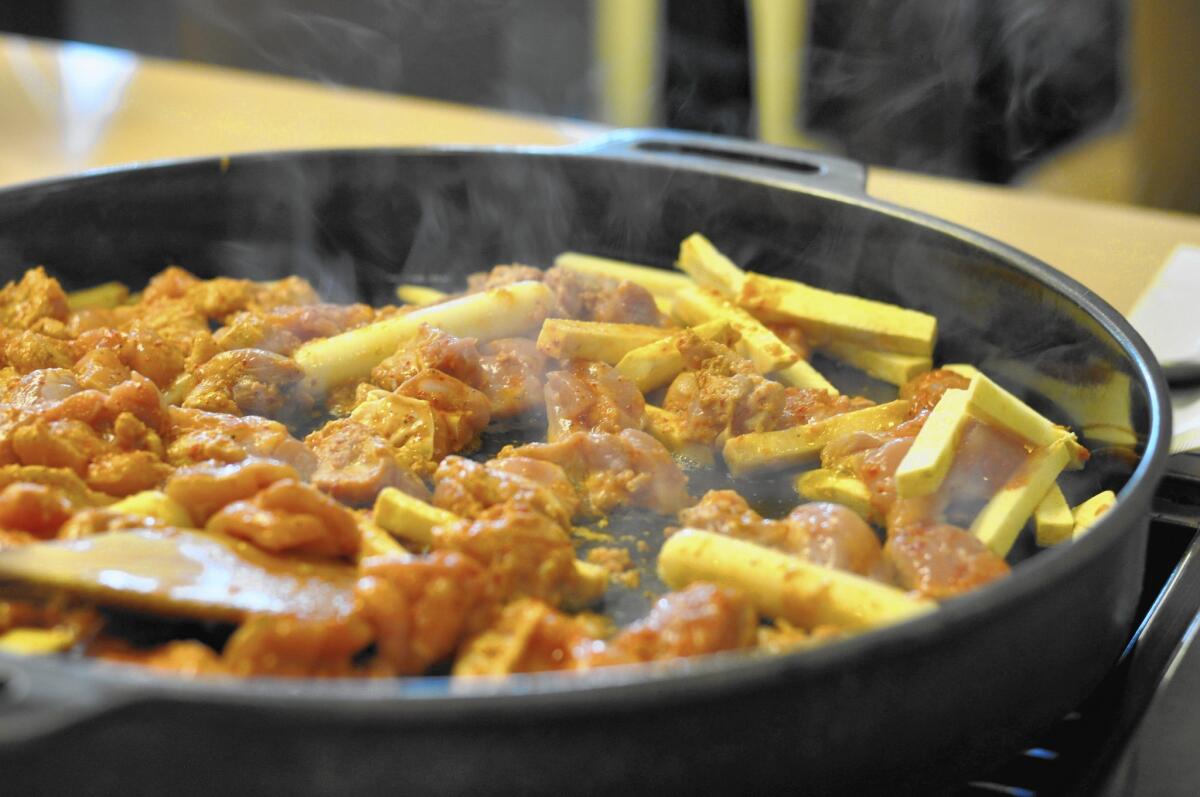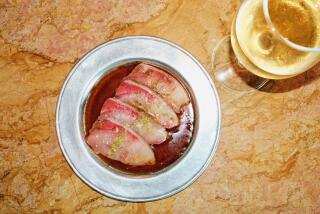Review: Mapo Galbi has a one-dish wonder

- Share via
In a recent issue of Lucky Peach, chef David Chang said that Mapo Galbi in Koreatown was his favorite restaurant to eat at in the world. Chang sometimes has lapses in taste, but in general he is someone you want to pay attention to when the subject turns to food: You could spend a blissful weekend eating nowhere but his various Momofukus in New York, and he is a regular at some of the best restaurants (and ramen bars) in the world.
Still, Mapo Galbi is not an obvious place for culinary epiphany. Its blocky hand-painted sign is untranslated. It occupies a plain storefront on a sleepy block; you will not be visiting it by accident. The waitresses don’t speak much English. You will not be watching the latest K-pop videos. The Food Network has never been.
Koreatown is full of restaurants that specialize in one dish, be it sliced short ribs, blowfish soup, blood sausage, grilled clams, military stew, steamed pig’s feet, bone broth or intestines. Mapo Galbi specializes in dak galbi, a kind of spicy Korean stir-fried chicken mostly overtaken by the faddish buldak, an even spicier Korean stir-fried chicken, which itself is starting to feel a bit old-fashioned. When it comes to specialties, dak galbi, which was at its peak when Duran Duran was dominating the airwaves, may not have the obvious appeal of hand-shaved noodles or even braised cod.
Counter Intelligence: Sign up for Jonathan Gold’s weekly newsletter
But dak galbi — have you ever had dak galbi? It is one of those dishes that is as much a worldview as it is a pleasant way to spend an evening; a mass of chicken and vegetables that can be mild enough for small children or cranked up nine-tenths of the way to pain; healthy almost in spite of itself; meager in its way yet almost infinitely expandable. To go out for dak galbi is to submit to its ritual, to spend 90 minutes floating through the cosmos on dak galbi time.
You are seated around a table with a rectangular pit in its center and a ventilation duct humming overhead. A waitress wrestles an enormous iron pan over to the table, clanks it down in front of you and flips on the gas. You will be handed bowls of tart water kimchi, pickled radish slices and thin marinated fish cake. You will probably be asked what you want to eat, but maybe not — you can technically get beef or pork belly, but in half a dozen visits to the restaurant I have never seen anybody order them.
What the waitress will actually say is: “Chicken?” Your job is to nod.
The standard order is one fewer orders of chicken than there are in your party, although the minimum is two orders per table and you will be missing the communal point of the experience unless there are at least four of you. So: three chickens. And some beer.
The pan is smoking hot now. The waitress dumps a big bowl of marinated chicken onto the iron pan and pats it down. You will wonder what the stubby white shapes in the pan might be: The thick round ones are the rice noodles called tteok, and the lozenges are cut from white sweet potatoes. A few minutes later the waitress spills a blizzard of slivered cabbage into the pan. You can hear the sizzle from across the room.
It is at this point that you start to wonder whether you should stir the mass with its wooden paddle yourself. Go ahead, it couldn’t hurt, although somebody at the table, maybe me, will start griping about the need to let the meat caramelize. Ignore him. Or don’t. The waitress will come along to stir it every so often in any case.
You may also notice that everything on the table has been scorched at one time or another: paddle, plastic dishes, water pitcher, all of it. The flames are fierce. To the amusement of the family at the next table, my unwatched chopsticks once burst merrily into flame.
Is the chicken ready to eat? It is not, although you will want it to be. A certain amount of the chile sauce gochujang will be sluiced into the pan — make encouraging motions if you’d like it extra-hot — along with a platter of ggaenip, a pungent Korean herb, like an extra-peppery basil, that makes Korean food taste truly Korean. If you are so inclined, you can ask for grated white cheese to be scooped on. It immediately melts into the chicken.
Until recently, I hadn’t been to Mapo Galbi in years — I slightly preferred the dak galbi at a now-closed place up on Vermont Avenue and then started frequenting a bul dak joint whose chicken was hot enough to cause its owner to fear litigation.
But what had I been missing? This: a sweet-hot mountain of chicken, cabbage melted down to translucent wisps, rice noodles that have become miraculously puddingy under a charred crust.
There is a second helping. Then a third. The chile sauce boils down to a thick, glossy puddle. The waitress comes by a split second before everything turns dark, stirs a bowl of rice into the smoking pan and pats the mass down. (She bats away your questing spoon.) She sprinkles the rice with shredded nori, the toasted seaweed you’ve seen at sushi bars. And finally she nods. The crunchy, half-burnt layer of rice at the bottom is widely considered the best part. And it is.
::
Mapo Galbi
An old-school barbecue place in Koreatown.
LOCATION
3090 W. Olympic Blvd., Los Angeles, (213) 487-2274
PRICES
Dak galbi, $17.99 per order
DETAILS
Open 3 to 10:30 p.m. daily. Credit cards accepted. Street parking.
RECOMMENDED DISH
Dak galbi
More to Read
Eat your way across L.A.
Get our weekly Tasting Notes newsletter for reviews, news and more.
You may occasionally receive promotional content from the Los Angeles Times.











